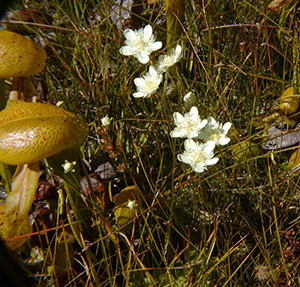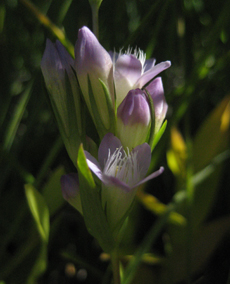Share the joy of a botanist’s annual October pilgrimage to the Darlingtonia Fens of the eastern Klamath Mountains
Cascade grass of Parnassus, Parnassia cirrata var. intermedia, is distinguished by its fringed petals and crown of threadlike, globe-tipped staminodes; here in the Klamath Ranges this late-blooming species often grows with California pitcherplant in serpentine wetlands.
Photo credit: Martin Lenz
Posted by: Julie K. Nelson, US Forest Service Botanist, Shasta-Trinity National Forest
I dreaded October as a child. Growing up on the Oregon coast, October promised rain and more rain—rain on my birthday, rain on Halloween, rainy rain rain.
What a difference 300 miles and the rain shadow of a mountain range makes! October here in far northern California on the Shasta-Trinity National Forest brings me nothing but pleasure. When fire season comes to a close, I plan my annual pilgrimage to the Darlingtonia fens of the eastern Klamath Mountains. I know what I will see. I will drive slowly up the winding canyon of the upper South Fork of the Sacramento River to the headwaters of Gumboot Creek.
When I walk into the meadow, I will notice how the harsh summer light has given way to a soft golden glow. While summer in this meadow is a riot of bright greens, pinks, oranges, and yellows, October is the time of purple and gold—purple asters, purple-blue gentians, golden grasses and sedges. I will reach down and part the grass, and get on my knees to see the gentians up close. I will remember that Aster alpigenus is now called Oreostemma alpigenum, thanks to someone’s phylogenetic research. I will still call it Aster alpigenus.
I will admire the fruits and seed pods of the season, especially the odd rattle-shaped cinnamon-hued capsules of Darlingtonia californica. I will probably shake a capsule or two. I will sit on an incense-cedar log and contemplate the soft pink leaves of western azalea, Rhododendron occidentale, and remember the lovely fragrance of their early summer flowers. As I wander farther up the stream, I may find fringed white blooms of the rare Parnassia cirrata, grass-of-Parnassus.
As the sun sinks into the trees, I will know it is time to go home. I will pick up several Jeffrey pine cones for my mantelpiece, and I will bid farewell to this place until next year. We will- the plants and I - collectively breathe a sigh of relief that summer is done and rest is coming.
Fall-blooming gentians are plentiful in the high, wet meadows of the Klamath Ranges. Rainier pleated gentian (Gentiana calycosa) is a striking, deep blue while the little autumn dwarf gentian (Gentianella amarella) is lavender.
Photo courtesy Julie NelsonFall-blooming gentians are plentiful in the high, wet meadows of the Klamath Ranges. Rainier pleated gentian (Gentiana calycosa) is a striking, deep blue while the little autumn dwarf gentian (Gentianella amarella) is lavender.
Photo courtesy Julie Nelson





